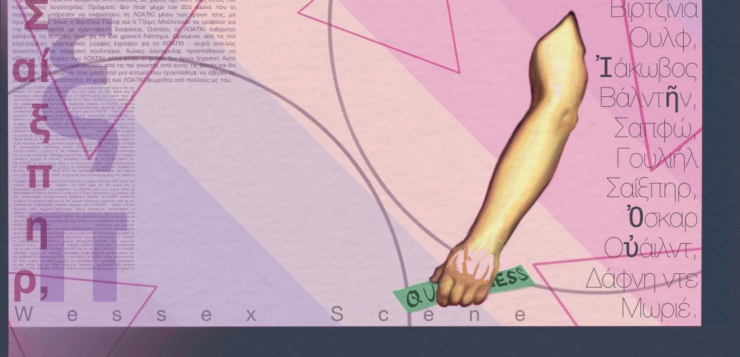Illustrated by Radu Sega
Queer writing is viewed by many as a relatively new space within the world of literature. Indeed, it was not until the 20th century that writers were able to freely express queerness through their works, with pioneers such as Virginia Woolf and James Baldwin writing about queerness with an unprecedented transparency.
Yet queer people have existed for much longer, and have been writing their stories for just as long. Some of the most celebrated literary figures wrote about queerness—often completely unknown to contemporary culture.
Centuries of censorship have attempted to erase queer stories, but these voices have not been forgotten. This article will unveil some of the most well-known of these voices and discuss their persistence throughout a history that tried to stamp out their true identities.
Sappho
Born in around 630 BC, Sappho was an ancient Greek poet who famously wrote romantic poetry about other women. Much of her poetry has been lost, and most of it remains only in fragments. In one fragment, she writes:
‘Sweet mother, I cannot weave –
slender Aphrodite has overcome me
with longing for a girl.’
Many early translations into English altered her poems, exchanging their female objects of desire for male ones. Sappho’s only surviving complete poem, Ode to Aphrodite, met this fate in the 1700s, and wasn’t corrected by translators until the 20th century.
Sappho was commonly framed as a schoolmistress in the 19th century to explain her affection towards the girls in her poems. In modern day, however, Sappho is regarded as a lesbian icon, and her queer legacy continues to impact modern culture.
In fact, the term ‘sapphic’ stems directly from her name, while the term ‘lesbian’ is derived from her birthplace, the island of Lesbos.
William Shakespeare
Shakespeare’s love sonnets frequently allude to same-sex attraction. Of his 154 sonnets, 126 express desire for an unknown male figure known as the ‘Fair Youth’, including Sonnet 18, which famously begins with the line ‘Shall I compare thee to a summer’s day?’
Sonnet 20 describes its subject as the ‘master-mistress of my passion’, assigning a feminine role to a male love interest in order to fit the heteronormative standards of the time.
Once again, 17th-century publishers altered Shakespeare’s poems, changing their pronouns from masculine to feminine until more than a century later. To this day, many scholars claim that the Fair Youth was just a friend of Shakespeare, demonstrating the lasting impact of the erasure of queer culture in history.
Oscar Wilde
Known for his wit and satire, Wilde’s works include his novel The Picture of Dorian Gray and many plays such as The Importance of Being Earnest.
The title character of The Picture of Dorian Gray is described as a ‘young Adonis, who looks as if he was made out of ivory and rose-leaves’. A man called Basil Hallwood immortalises Dorian’s beauty in a portrait, and they form a close relationship with one another in an overt depiction of same-sex desire.
Unfortunately, this novel was later used as evidence of Wilde’s homosexuality in a criminal trial. Wilde was convicted of gross indecency, and died shortly after his release from prison at the age of 46.
In the most extreme form of erasure, one of the 19th century’s most compelling literary voices was completely eradicated.
Daphne du Maurier
Daphne du Maurier was a 20th century writer known for novels such as Rebecca and Jamaica Inn. Du Maurier’s attraction to and potential relationships with women are well-documented, yet she also stated that she possessed a ‘decidedly male energy’, leading many to believe she was transgender.
From childhood, she had a male alter-ego whom she called Eric Avon—as biographer Margaret Forster writes, ‘Daphne was convinced she was a boy’. The unnamed female protagonist of Rebecca constantly feels uncomfortable in her own skin, and experiences an intense jealousy of her husband’s previous wife, Rebecca, almost to the point of obsession.
Perhaps this reflects du Maurier’s disconnect from female identity, and channels her own inability to be satisfied in a female body. Or perhaps the novel expresses her suppressed desire for women.
Either way, Rebecca’s queer themes evoke du Maurier’s grappling with her own identity, which she wasn’t allowed the luxury of exploring in the oppressive society in which she lived.
Across the world, queer censorship continues. While there is still a long way to go, writers may now express queerness with more freedom than ever before. These iconic literary figures prove that queerness can prevail in spite of society’s insistence to erase it.




